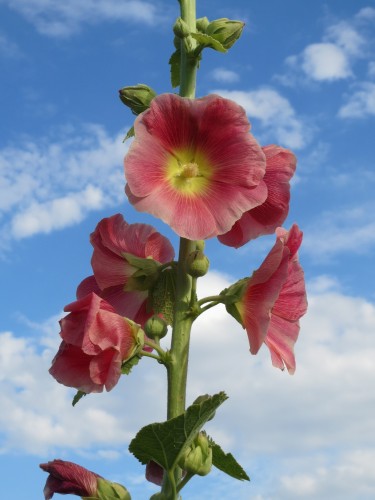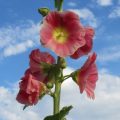- The Miraculous Shiny Bush Plant - January 18, 2021
- Colorful, Edible and Medicinal Celosia - January 10, 2021
- Radish, a Nutritional Power House - December 19, 2020
Hollyhock, also known as Alcea rosea, is an erect, herbaceous, biennial flowering plant in the Malvaceae family. It is thought to have originated from South-Western China and is native to Europe and Asia. Since the 15th century, the plant has been cultivated in Europe for its health-enhancing benefits plus its beautiful, attention-grabbing purple to pink flowers. Today, alcea rosea’s medicinal uses and its aesthetic appeal have seen it naturalized in many regions of the world with temperate climates.
[Note: The Right Flowers is not a medical site. Knowledge of and information about the therapeutic benefits and applications of flowers, while known through the ages, does not constitute medical advice. If you are having health issues, you should consult with a physician.]
In ancient times, hollyhock was a highly popular plant as it was thought to reflect God’s love due to its hardy nature. In Tibetan medicine, the roots and blossoms were used for inflammation of the kidneys and the womb. They were also used to stop the involuntary release of semen and stanch vaginal discharge.
While hollyhock was always viewed as a hardy plant, with time, the plant became vulnerable to multiple pests and diseases including a fungus commonly known as rust that has largely contributed to its decimation, which explains why this flowering plant is no longer popular for its health benefits unlike in the past.
Alcea rosea medicinal uses include:
Easing digestive problems
Hollyhock blossoms have been known to have a positive effect on the digestive system for years. According to an 1859 medical book, hollyhock flowers were mixed with bayberry, poplar bark, and goldenseal to make a potent herbal concoction for promoting digestion and enhancing bowel movement. Hollyhock is also good for treating peptic ulcers, colitis, and mouth ulcers.
Respiratory system
Hollyhock is highly effective in managing conditions that affect the respiratory system. Oral infusions made from hollyhock’s flowers, roots and seeds are very good for soothing irritated or sore throats and curing dry coughs. The infusion is also great for clearing and decongesting blocked airways.
Oral health
Hollyhock blossoms have powerful anti-inflammatory and antiseptic properties which make it ideal for managing oral health.
Fever
Hollyhock contains antipyretic properties which make it a handy remedy for high fever. Its infusion, commonly known as hollyhock tea, boosts blood circulation and warms up the body. Enhanced blood circulation promotes sweating and helps in detoxification which keeps the body hydrated and assists in managing fever.
Haircare
Hollyhock’s blue blossoms make excellent natural hair dye. To make the dye, add the blue flowers to boiling water and allow to simmer for 10 minutes. Strain, allow to cool and use at your pleasure.
Skincare
Hollyhock is a natural skin moisturizer and conditioner. It has properties that hydrate and tone the skin making it soft and flexible which is great for preventing premature aging.
Though this flowering plant is a beautiful addition to your yard or garden, its usefulness goes beyond its aesthetic appeal. Its fame and prevalence may have been negatively impacted by pests and fungal attacks, but alcea rosea medicinal uses still give it a seat among the highly sought-after herbal plants.





